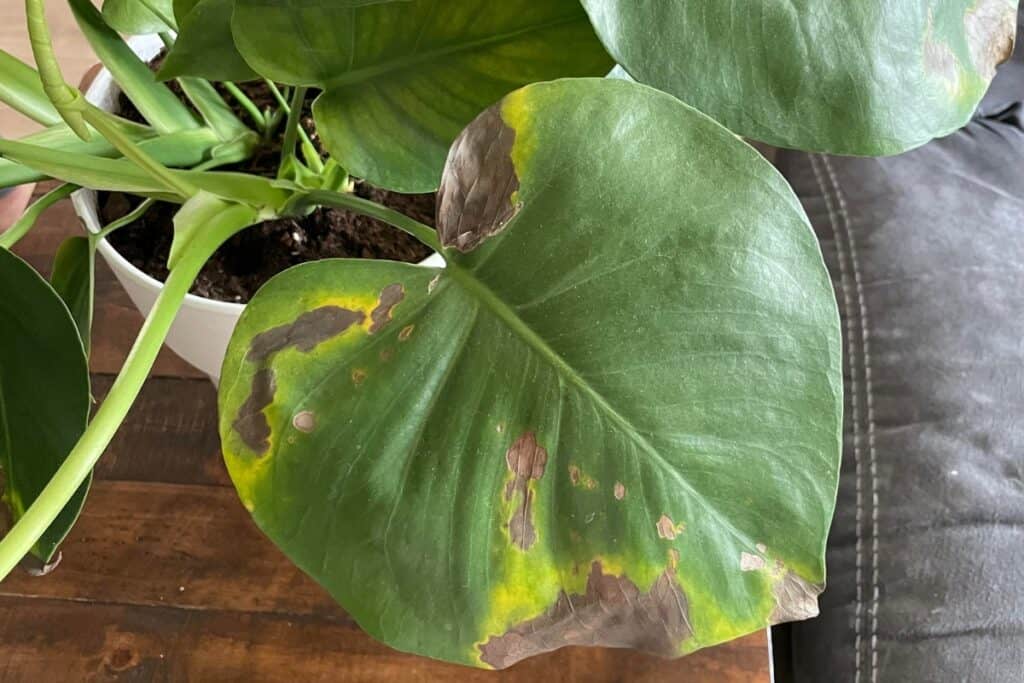Brown spots on Monstera leaves appear like unwelcome visitors, turning vibrant green foliage into a puzzling patchwork of discoloration. These mysterious marks often signal underlying problems that range from simple watering mistakes to more complex environmental issues. Plant owners frequently discover these spots during routine care, only to wonder whether they’re dealing with fungal infections, pest damage, or basic care errors. The key lies in understanding that each type of browning tells a specific story about what’s happening beneath the surface.

Contents
Common Causes Behind Those Troubling Brown Patches
When brown spots appear on Monstera leaves, plant owners often panic, but understanding the root causes can transform concern into confidence. The most common culprits include excessive direct sunlight, which creates distinctive leaf discoloration patterns on sun-facing foliage. Overwatering ranks equally problematic, causing soggy brown patches that signal root distress.
Tap water chemicals accumulate over time, mimicking nutrient deficiency signs through gradual browning. Low humidity below 40% triggers tip browning, while over-fertilization creates salt buildup damage. Fungal diseases like leaf spot produce characteristic yellow-to-brown progression, and various pests leave telltale damage patterns that experienced growers learn to recognize quickly.

Watering Mistakes That Lead to Leaf Damage
Although watering seems straightforward, improper moisture management ranks as the primary destroyer of Monstera leaves, creating brown spots that spread faster than most plant owners anticipate. Overwatering suffocates roots in waterlogged soil, triggering fungal growth that manifests as dark, soggy patches on foliage. The key lies in understanding proper watering frequency—only water when the top inch of soil feels dry to touch. Consistently checking soil moisture prevents the deadly cycle of root rot. Tap water compounds problems further, as chemicals accumulate over time, mimicking over-fertilization symptoms and causing additional browning throughout the plant’s leaf structure.
Environmental Factors Affecting Your Plant’s Health
Why do Monsteras develop mysterious brown spots even when watering schedules stay perfect? Environmental factors often create the real culprit behind leaf damage.
Light exposure plays a major role in plant health. Direct sunlight burns leaves, creating brown patches on surfaces closest to windows. Monsteras prefer filtered light, thriving in bright but indirect conditions.
Humidity levels below 40% cause leaf tips to brown and develop large colorless patches. These tropical plants demand humidity above 70% for ideal growth. Temperature stress from cold drafts or heat sources also damages leaves, causing browning and wilting throughout the plant.
Identifying and Treating Fungal Diseases
Fungal diseases present themselves as distinctive patterns on Monstera leaves, making identification relatively straightforward once gardeners know what to look for. Leaf spot creates yellow patches that gradually fade to brown, while rust appears as distinctive orangey-brown spots across foliage. Effective fungal identification requires examining spot texture and color progression over time.
Disease treatment starts with immediate pruning of infected leaves using sterilized scissors. This prevents spores from spreading to healthy tissue. Severely infected plants may need complete disposal to protect nearby houseplants. Improving air circulation and reducing humidity around affected areas helps prevent future outbreaks.
Effective Pest Management Strategies
Successful pest management begins with swift isolation of affected Monsteras, preventing infestations from spreading to neighboring plants. Effective pest identification techniques include examining leaf undersides with a magnifying glass, looking for webbing, sticky residue, or tiny moving dots. Spider mites create fine webs, while mealybugs appear as white cotton clusters.
Natural pest solutions work best for indoor plants. Neem oil requires thorough coverage every 5-7 days until pests disappear. Insecticidal soap kills on contact, making it perfect for immediate relief. Start by rinsing plants under lukewarm water, then apply treatments during evening hours to prevent leaf burn.
Prevention and Long-Term Care Solutions
While treating existing brown spots requires immediate action, establishing consistent preventive care routines proves far more effective than constantly fighting problems. Maintaining ideal humidity between 40-70% prevents leaf tip browning and creates inhospitable conditions for pests. Weekly soil maintenance checks guarantee proper drainage and prevent overwatering complications. Regular leaf inspections, ideally every few days, catch issues before they spread throughout the plant. Quarantine new plants for two weeks before introducing them to established collections. Clean plant debris promptly, rotate the plant monthly for even light exposure, and flush soil quarterly to prevent salt buildup from fertilizers.
